IAC News
IAC News No.118, August 2022
Japan Society of Civil Engineers International Activities Center August 3, 2022 IAC News No.118
Transforming JSCE into an Outward-Looking,
Open Organization Where Diversity Is Valued
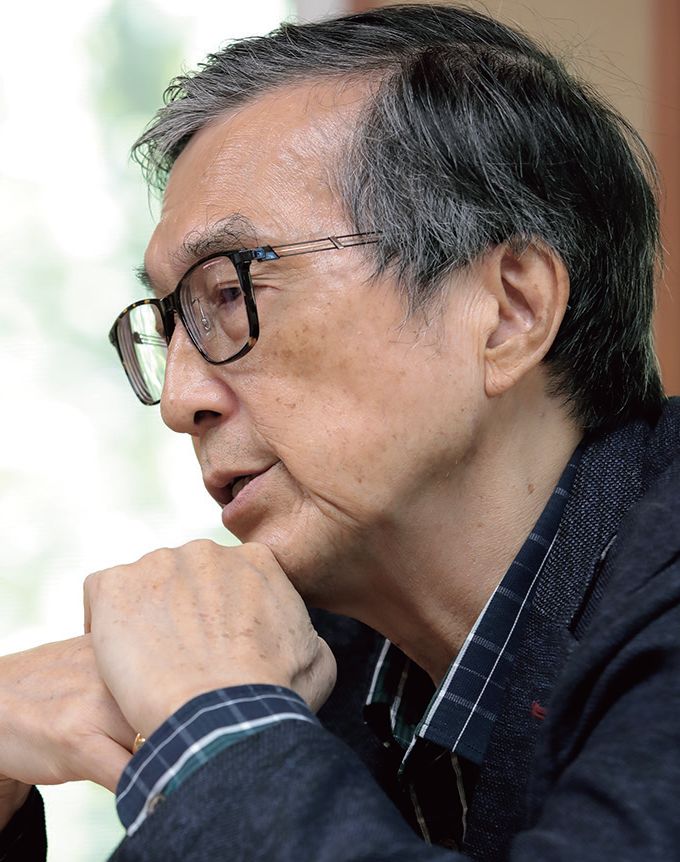 Tamon Ueda
Tamon Ueda
110th JSCE President
*Interview in the August issue of JSCE Magazine
<At the Forefront of Research and Education from Hokkaido University to Shenzhen University>
Congratulations on becoming President of JSCE.
Born in Tokyo, you (President Ueda) have been teaching at Hokkaido University for many years
Back when I enrolled at the University of Tokyo, Prime Minister Kakuei Tanaka’s Theory of Remodeling the Japanese Islands sparked great debate in society, and interest in civil engineering was very high. Inspired by the completion of the Kurobe Dam, which was said to be “the biggest construction project of the 20th century,” I aimed for a career in civil engineering.
I was taught by Professor Hajime Okamura at the Concrete Laboratory, spent two years studying at a university in the United States, and after spending three years as a faculty member at the Asian Institute of Technology in Thailand with the assistance of Professor Fumio Nishino, I took up a position at Hokkaido University. As I grew up in Tokyo, Hokkaido was somewhere I always wanted to go. I could have got a job at a research institute of a private company in Tokyo, but I think I made the right choice.
What have you done in your time at JSCE?
As I majored in concrete structures and hybrid structures, I have been a permanent member of the JSCE Concrete Committee since the 1990s, and served as the first chairperson of the Hybrid Structure Committee, which was newly established in 2005.
You are known for being particularly “internationally-minded” at JSCE, and have also filled the big shoes of Senior Director of the International Activities Center for seven years since its establishment in 2012.
While I’m flattered to be labeled “internationally-minded”, I’m not consciously so at all. However, in being made President of JSCE, I would like to take this opportunity to focus my efforts on my unfinished work from my time at the International Activities Center. The biggest challenge is how we shift the inward-looking nature of Japanese civil engineering to focus outward instead. Details of newly established committees and so on will be explained in the Message from the President section in the subsequent issues of the JSCE Magazine.
After leaving Hokkaido University, Shenzhen University in China offered me a position to work as a professor. Currently living in Shenzhen has made me realize in various situations the current stagnation in civil engineering in Japan. Especially in terms of infrastructure, when I studied abroad 40 years ago, the United States, which has excellent international airports all over the country, was number one in the world, but now China, with its remarkable economic growth, is a rising star. Meanwhile, looking at Japan, the infrastructure that has been developed with great investment after the war now has a lot of problems. Even if you take the expressways and the Shinkansen as examples of such infrastructure, is it really world-class in terms of its functionality? I feel that now is the time in which we need to take a good look at our infrastructure and thoroughly verify it.
<Creating Opportunities for Young People, Women, and International Members to Be Better Heard>
Are there any differences between Japan and China in terms of research and education?
Given that Japan and China have overwhelmingly different populations, of course, there are differences, but China is a competitive society when it comes to researchers, too. The number of papers submitted, the size of grants, etc., they all become personal achievements and help to support one’s career. Young people are extremely motivated, and the efforts and achievements of these young individuals are raising the bar for civil engineering research throughout the country. As scholarships for doctoral students are also substantial and the students’ costs of living are covered, China attracts excellent human resources. I would really like Japan to also learn from this.
If you just compare China and Japan like this, it may seem that there is nothing good about Japan, but I am an optimist! There are without doubt very talented young researchers and engineers in Japan. Creating opportunities so they are heard more is one of the things that I want to do.
I also expect big things from our female members in particular. There are many female researchers and engineers who flourish in China and other countries. I often think that it will be women who overturn this sense of stagnation in the world. As the overall number of female members is small in Japan, I would like to listen carefully to what they have to say so that they are properly heard.
What do you think about international members from the perspective of diversity?
Unfortunately, until now, we have not been able to provide opportunities to actively listen to and discuss the thoughts of our international members. It’s time to change this as well. We will create opportunities where young people, female members, and international members can easily say what they think, and work on solving issues from the perspectives of everyone. The accumulation of each of these opportunities will lead to creating opportunities in which they can make decisions. I think that creating this series of stages is absolutely vital for the future of civil engineering.
Please let our readers know what they can expect from the JSCE Magazine in the future.
In November 2021, JSCE and the Architectural Institute of Japan signed a memorandum of understanding. As I mentioned in the July issue in my inaugural address, these two organizations will work together to address global issues. As part of this, I would like to propose to the editorial committee members a joint project between the two academic societies, which will be featured regularly in our respective academic journals.
Secondly, I would like us to further advance the digitization of the JSCE Magazine, a process that is in progress as we speak. Recently, the automatic machine translation function has also been enhanced, so even the international members I just mentioned who are not so good at Japanese should be able to access information in real-time by using the translation function. I can also enjoy the latest information in the JSCE Magazine at the same time as everyone while I am in Shenzhen. The JSCE Magazine is also a good way to sort information, so I hope to receive prompt feedback on my efforts as president as well.
Thank you for your time today.
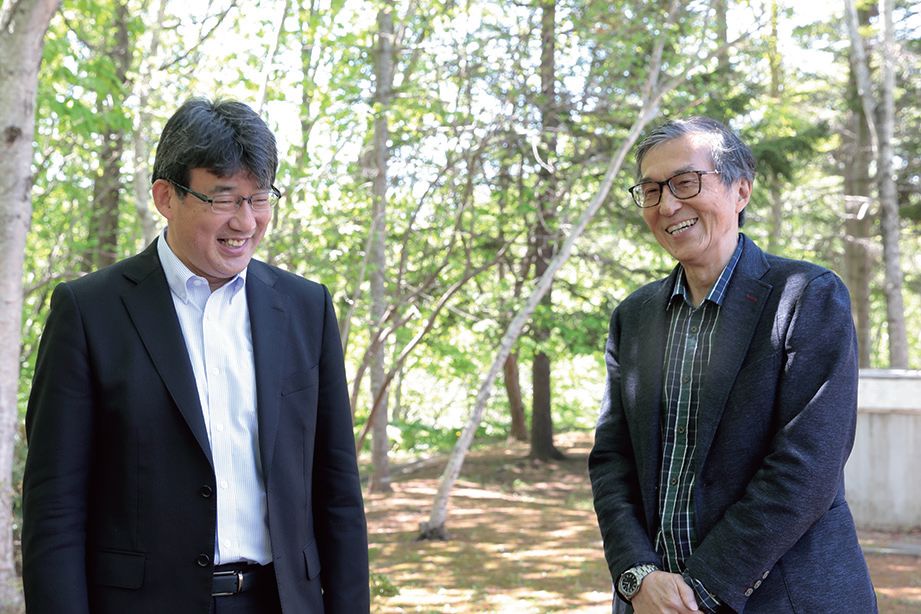
In Ishikari-gun, Hokkaido on Wednesday, May 18, 2022
【Interviewer: Ichiro Iwaki, Chair of the Editorial Committee on JSCE Magazine】
【Written by Yuko Sato, Photos by Rumiko Ito】
Japanese Civil Engineers the Global Leaders Symposium Series: Symposium No. 20
“Construction of Submersible Bridges in Myanmar”
On Tuesday, May 24, 2022, the Japanese Civil Engineers the Global Leaders Symposium Series No. 20 “Construction of Submersible Bridges in Myanmar” was held by the JSCE International Activities Center both online and in person. In Myanmar, unlike ordinary bridge construction projects, the Ministry of Foreign Affairs’ grant aid was used to construct submersible bridges that can be constructed at low cost, taking into account the needs of local residents and the specific circumstances of the area. Against this backdrop, this symposium discussed Japanese engineers directly instructing local engineers and local residents not only about the design and construction of the bridges but also about their maintenance after completion. The construction of submersible bridges has been facilitated by Japan Infrastructure Partners (JIP) since 2016. The bridges have been highly praised by local residents, the national government, and local governments in Myanmar, with 12 bridges completed so far. This initiative was awarded the Mino Best Project Award at the 2021 Annual Meeting of the Road Engineering Association of Asia & Australasia (REAAA). The theme of this symposium was the construction of submersible bridges. During the symposium, it was explained that the scale of each submersible bridge construction project is small, unlike projects that Japan has traditionally supported the infrastructure development of in developing countries. Even so, this project is evidence of the experience and achievements of Japanese civil engineers, who were highly praised not only by the Myanmar government but also by local residents, being held in great awe overseas.
At the beginning of the symposium, Tamon Ueda, President of the Japan Society of Civil Engineers, gave an opening speech. During his remarks, he emphasized the significance of the fact that efforts were being undertaken with local residents leading maintenance after the construction of the submersible bridges, with the project accurately responding to the needs of the region.
The words of President Ueda were followed by Mr. Tadahiko Nakao, President of Japan Infrastructure Partners, who introduced an overview of the project, and Mr. Hajime Asakura, Vice President of Japan Infrastructure Partners, who gave a detailed explanation of the technical efforts involved in implementing the project. Next up was Mr. Toshio Matsuda, Director of the Non-Governmental Organizations Cooperation Division of the Ministry of Foreign Affairs, who introduced Grant Assistance for Japanese NGO Projects and showed a willingness to consider working together on a similar submersible bridge project in the future. Lastly, Mr. Chinatsu Hyodo, who was involved in the field surveys in Myanmar, talked about the expectations and assessments of the local residents, and also used footage of a ceremony to mark the opening of a bridge to also highlight how the local residents are delighted with the construction of the submersible bridges.
The construction of the submersible bridges in Myanmar, which was covered throughout this symposium, is an extremely beneficial project for the rural areas of Myanmar. There are also requests from other regions in the country to build more submersible bridges. It is expected that the development of submersible bridges will continue to be led by Japan Infrastructure Partners with the cooperation of the Ministry of Foreign Affairs, leading to greater living standards for the local residents in Myanmar.
*Overview of REAAA Held in Manila, Philippines
https://jip.or.jp/202109-mino-best-project-award-ceremony/
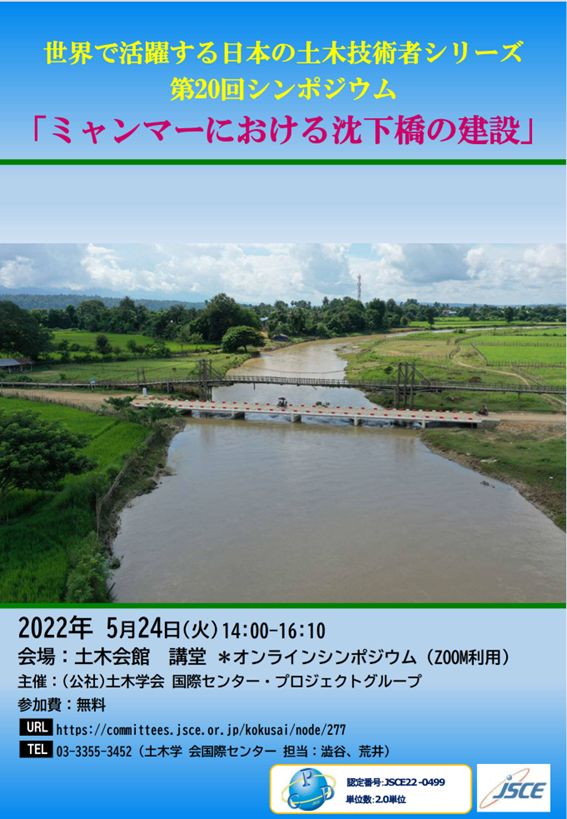
<Program>
• Date: Tuesday, May 24, 2022
• Venues: JSCE Hall, Zoom webinar (online)
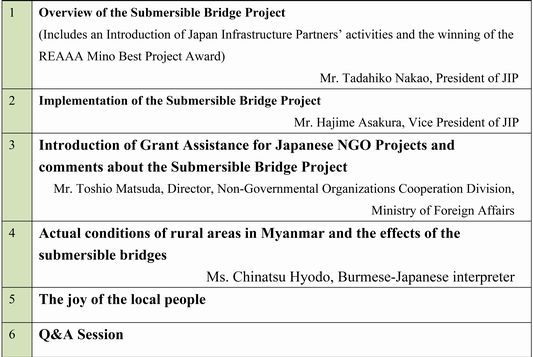
【Reported by Reported by Hidenori Yoshikane, Project Group, IAC】
International Activities Center’s Recent Project
1. President Ueda Project
Two months have passed since the President Ueda Project has properly gotten up and running. As preparations started last year, however, discussions, event planning, and the posting of information on the narrowed-down themes are in full swing. For example, on Friday, August 5, the Symposium* on the Succession and Development of Long Bridge Technology and Human Resources in Overseas Projects (hosted by the Civil Engineers Global Implementation Subcommittee) will take place both online and in person. The symposium will welcome civil engineers involved in the construction of long bridges in Japan and overseas to talk about the development of marine bridge projects in Japan, a world leader in this respect, as well as technological development and the training of human resources.
The Global Vision Examination Subcommittee for Academic Research Activities in Civil Engineering and the Subcommittee for Examining the Forming of Projects to Be Rolled Out Internationally are holding discussions to pave the way to enhance the international competitiveness of academia and research in Japan and form projects that can be rolled out overseas. Going forward, we can surely expect activities such as workshops, seminars, and surveys to increase. These activities will be introduced in the President Project 2020 section of the JSCE Magazine. Be sure to check them out.
* Symposium HP: https://committees.jsce.or.jp/2022_Presidential_Project02/node/13
2. 2022 JSCE Annual Meeting
This year’s JSCE Annual Meeting will be held from Wednesday, September 14 to Friday, September 16 at Kyoto University and the Kyoto International Conference Center. As the International Program, the 24th International Summer Symposium & International Workshop for Young Civil Engineers will be held as a session at both the International Special Conference on the morning of September 14 and the JSCE Annual Conference on September 15 and 16. The International Special Conference is entitled Crossroads@Junctions, Paths, and Future in Civil Engineering, and veterans and upcoming engineers from Japan and overseas will gather to learn what each other has taken from experiences at crossroads in the past and to consider how to use these insights to overcome future crossroads and how to choose one’s path going forward. We expect to welcome people from the American Society of Civil Engineers (ASCE), the Chinese Civil Engineering Society (CCES), JICA, universities, general contractors, and more. Meanwhile, the workshop consists of two parts: (1) research presentations by upcoming engineers and researchers and (2) group discussions on various issues. On the theme of utilizing AI and DX technologies in civil engineering, this workshop will see participants consider possibilities for taking advantage of said technologies in fields such as structural engineering, hydraulic engineering, geotechnical engineering, and disaster prevention, and consider their effectiveness and issues, as well as solutions to said issues. You cannot help but find yourself rooting for upcoming engineers from Japan and overseas when watching them working together to come up with an answer while contemplating this and that. Whether you are attending the JSCE Annual Meeting or not, please stop by and take a look.
https://committees.jsce.or.jp/kokusai/node/286
3. International Civil Engineers Group
The International Civil Engineers Group of the International Activities Center started as a working group during the coronavirus pandemic and to date has carried out most of its activities online. For example, last year, the International Civil Engineers Group held the Salon for International Students and Engineers in Japan, with international students and engineers as well as Japanese companies sharing their thoughts about the current situation and issues surrounding internships in Japan and their expectations for the future. I encourage you to visit this webpage to see what happened on the day (https://committees.jsce.or.jp/kokusai/node/220).
Since the start of this year, under the leadership of Yoshinori Izawa (Hazama Ando Corporation), Director of the International Activities Center, the International Civil Engineers Group was promoted from working group to group status. Taking advantage of the relaxation of regulations regarding COVID-19 countermeasures, the International Civil Engineers Group is slowly but surely holding meetings in both in person and online. The themes for this year’s activities were narrowed down to (1) support for international students, (2) support for international civil engineers, and (3) networking and posting of information. Three teams were then formed. The members are motivated to try to produce satisfactory results in a fun way while making an effort to share information between teams. By all means get involved!
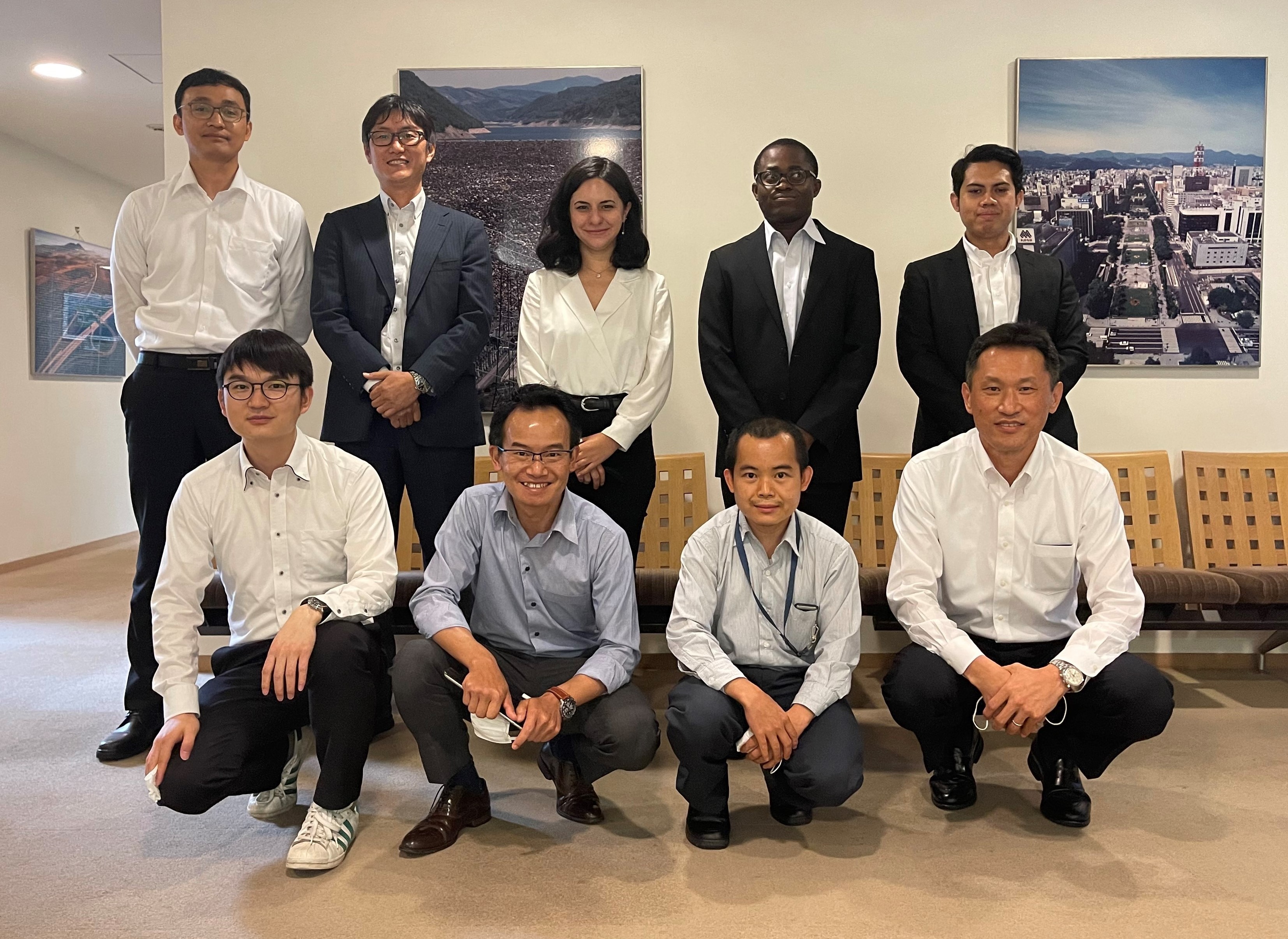
The International Civil Engineers Group, IAC
Updates
◆JSCE-ASCE Infrastructure Resilience Research Group: https://www.infraresil.jp/
◆2022 JSCE Annual Meeting International Program (Japanese): https://committees.jsce.or.jp/kokusai/node/286
◆JSCE Feedback Web Form「多門に多聞&多問」
https://committees.jsce.or.jp/chair/node/59
◆The International Infrastructure Archives
– A Compilation of Japan’s Greatest Projects in Transfer of Civil Engineering Technology in Service –
http://www.jsce.or.jp/e/archive/
◆IAC “News Pick Up!!” on the JSCE Japanese website
https://committees.jsce.or.jp/kokusai/iac_dayori_2022
◆Summary of featured articles in JSCE Magazine Vol. 107, No.8 August 2022
http://www.jsce-int.org/pub/magazine
◆Journal of JSCE
https://www.jstage.jst.go.jp/browse/journalofjsce
◆The 9th Civil Engineering Conference in the Asian Region (CECAR9)
https://cecar9.com/
◆The 1st International Conference on Food Waste to Food Sustainability 2022
https://www.polyu.edu.hk/pfs/index.php/392861?lang=en
◆The 4th Asian Concrete Federation (ACF) Symposium on Emerging Technologies for Structural Longevity (ACF2022_ETSL): https://acf2022.aconf.org/index.html
◆The 9th International Conference on Flood Management (ICFM9)
https://www.icfm9.jp/index.html
◆74th ECCE GENERAL MEETING PRESS RELEASE
https://www.dropbox.com/s/316vqqho6by850r/ECCE_Press%20Release_20220720....
Subcription
The IAC News is one of the communication tools to share information and ideas with the members. We would like to invite you, your friends and colleagues to join the communication and to subscribe the IAC News. Please register online: (http://www.jsce-int.org/node/150). We look forward to meeting you.
